If you are untrained, then day trading in stocks is very risky. But if you have an eye for spotting market trends, then you make profits. Learning about the technical analysis indicators will help you in doing so.
“Technical analysis is a skill that improves with experience and study. Always be a student and keep learning.” – John Murphy
There was a time long ago when trading in stocks was a simple game of buying and selling. But now it is not. Technical analysis is an art and science of predicting future prices from past price movements that have given investors new technical analysis indicators.
Let us discuss those tools today:-
- Top 9 Widely Used Technical Analysis Indicators:
- 1. The On-Balance-Volume indicator (OBV)
- 2. The Accumulation/Distribution line (A/D line)
- 3. The Average Directional Index (ADX)
- 4. Aroon
- 5. Moving Average Convergence Divergence (MACD) Indicator
- 6. The Relative Strength Index (RSI)
- 7. The Stochastic Oscillator
- 8. Fibonacci Retracement
- 9. Parabolic SAR
- Frequently Asked Questions
- Bottomline
Top 9 Widely Used Technical Analysis Indicators:
Here are some of the most widely used technical analysis indicators in stock trading:
1. The On-Balance-Volume indicator (OBV)
The On-Balance-Volume is a technical analysis indicator used to measure the positive and negative flow of volume in a security over time. It is a momentum indicator that measures positive and negative volume flow.
This indicator was developed by Joseph Granville. According to him, when volume increases sharply without a significant change in the stock’s price then the price will eventually jump up and when volume decreases sharply without a significant change in the stock’s price then the price will eventually jump down.
Calculation:
There are three rules implemented when calculating on-balance volume (OBV):
- If today’s closing price is higher than yesterday’s closing price
Current OBV = Previous OBV + today’s volume
- If today’s closing price is lower than yesterday’s closing price
Current OBV = Previous OBV – today’s volume
- If today’s closing price equals yesterday’s closing price
Current OBV = Previous OBV
Interpretation
According to Granville’s theory, a rising OBV reflects positive volume pressure which can lead to higher prices. Whereas falling OBV reflects negative volume pressure which can lead to lower prices. OBV will often move before prices. One can expect prices to move higher if OBV is rising while prices are either flat or moving down. Similarly one can expect prices to move lower if OBV is falling while prices are either flat or moving up.
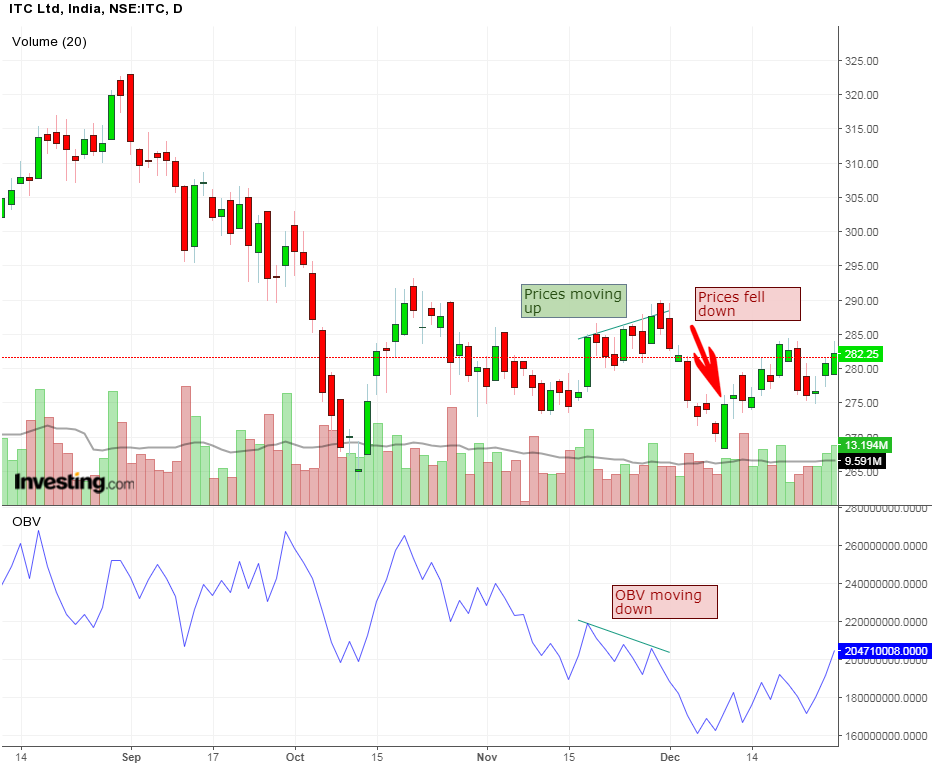
From the above chart of ITC we can see that the prices were moving up although OBV was moving down. Eventually, the prices fell down.
2. The Accumulation/Distribution line (A/D line)
Accumulation and Distribution are among the most commonly used technical analysis indicators to determine the money flow in and out of security.
This indicator is developed by Marc Chaikin to measure the cumulative flow of money in and out of the security. This indicator was named earlier as the Cumulative Money Flow Line.
Learn about various Types of Technical Analysis Indicators for free with ELM School
This indicator attempts to gauge supply and demand by determining whether the investors are buying (accumulating) or selling (distribution) a particular stock.
Calculation:
The money flow indicator is calculated by :
(close – low) – (high – close)
This value is then divided by the high minus the low.
(close – low) – (high – close) / (high – low)
The final number is the money flow multiplier.
Interpretation:
This indicator helps to show how demand and supply factors are influencing the price. Accumulation/ Distribution can move in the same direction as price or may have an inverse slope.
If the security’s price is in a downtrend while the accumulation/distribution line is in an uptrend then the indicators show that there may be buying pressure and the prices may reverse. Similarly, if a security’s price is in an uptrend while the accumulation/distribution line is in a downtrend then the indicator shows that there may be selling pressure and the prices may reverse.
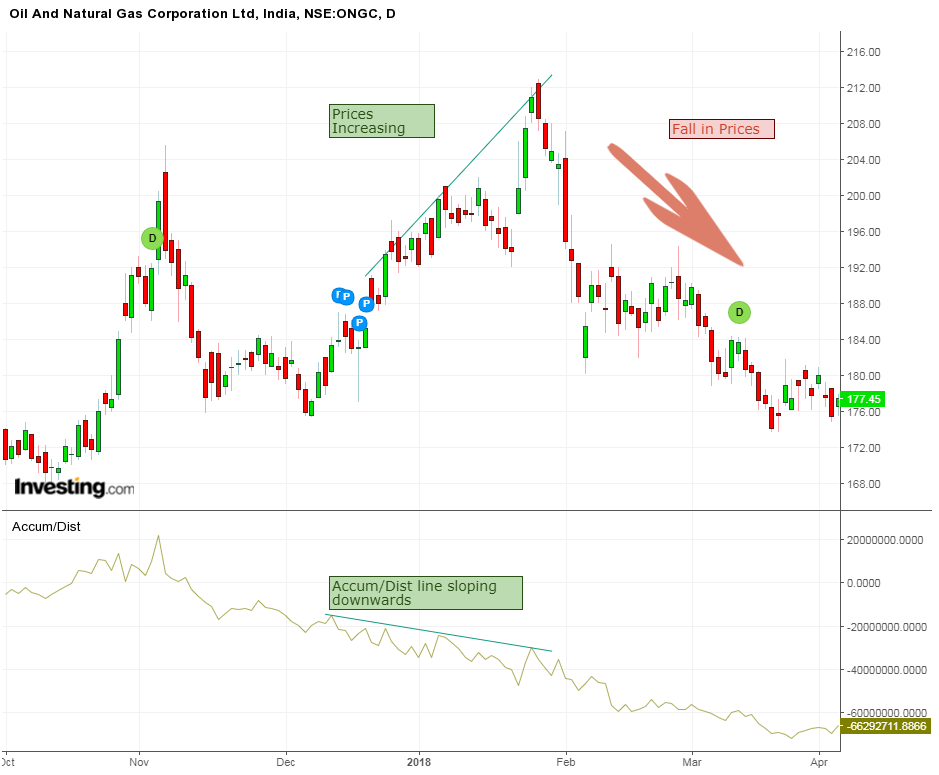
We can see from the above daily chart of ONGC that the prices were in an uptrend, whereas the accumulation/distribution line was sloping downwards, which showed the selling pressure in ONGC and prices eventually reversed, and the trend became bearish.
3. The Average Directional Index (ADX)
The Average Directional Index (ADX) is a trend indicator used to measure the strength and momentum of a trend. Trading in the direction of a trend reduces risk and also increases profit potential.
The Average Directional Index (ADX) is used to assess when the price is trending strongly. ADX calculations are based on a moving average of price range expansion over a period of time. The default setting is 14 bars.
Trend Strength
The values are important for differentiating between trending and non-trending conditions. ADX readings above 25 suggest that the trend is strong enough for trend trading strategies. Similarly, ADX below 25 suggests avoiding trend trading strategies.
| ADX Value | Trend Strength |
| 0-25 | Absent or Weak Trend |
| 25-50 | Strong Trend |
| 50-75 | Very Strong Trend |
| 75-100 | Extremely Strong Trend |
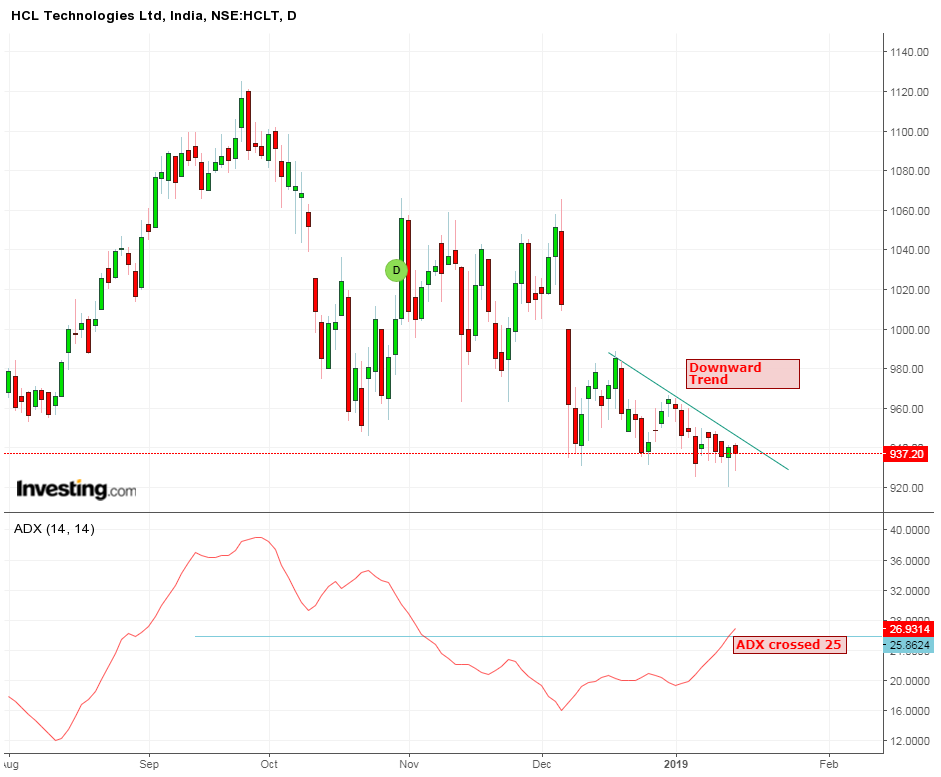
From the chart below of HCL Technologies, we can see that the stock is in a downtrend and ADX is confirming that it is a strong downtrend.
4. Aroon
Aroon Indicator is a technical analysis indicator used to measure whether a security is in a trend. It is used to identify when trends are likely to change direction. This indicator measures the time it takes for the price to reach the highest or lowest points over a particular timeframe.
The indicator consists of the “Aaroon up” line and “Aroon down” line. The Aaron up line measures the strength of the uptrend whereas the “Aaron down” line measures the strength of the downtrend.
Calculation:
- Aroon Up – ((N – Days Since N-day High) / N) x 100
- Aroon Down – ((N – Days Since N-day Low) / N) x 100
The “N” indicates the number of periods used for the indicator. By default, many traders use the Aroon indicator over 14 periods.
Interpretation:
There are three stages in order to identify an uptrend signal:
- Firstly the aroon lines will cross. The upward signal is when Aroon-Up moves above Aroon-Down. This shows that new highs are becoming more recent than new lows.
- Secondly the Aroon lines will cross above or below 50.
- Thirdly one of the lines will reach 100. Aroon up reaches 100 and Aroon down remains at low levels.
Reverse engineering these stages will give you the downward signal.
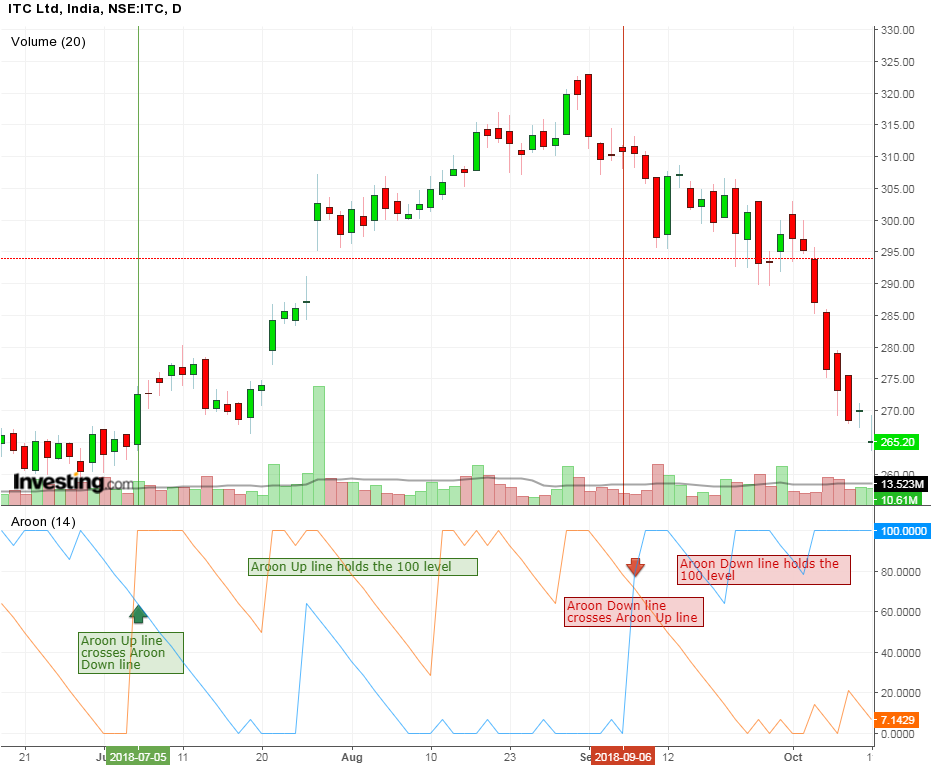
5. Moving Average Convergence Divergence (MACD) Indicator
The Moving Average Convergence Divergence (MACD) is a trend-following indicator and momentum indicator which shows the relationship between two moving averages of a security’s price.
Calculation:
Step1. Calculate a 12-period exponential moving average of the close price.
Step2. Calculate a 26-period exponential moving average of the close price.
Step3. Subtract the 26-period moving average from the 12 period moving average. This is the fast MACD line.
Step4. Calculate a 9-period exponential moving average of the fast MACD line calculated above. This is the slow or signal MACD line.
Interpretation:
As shown on the following chart, when the MACD falls below the signal line, it is a bearish signal line and when the MACD rises above the signal line then the indicator gives a bullish signal.
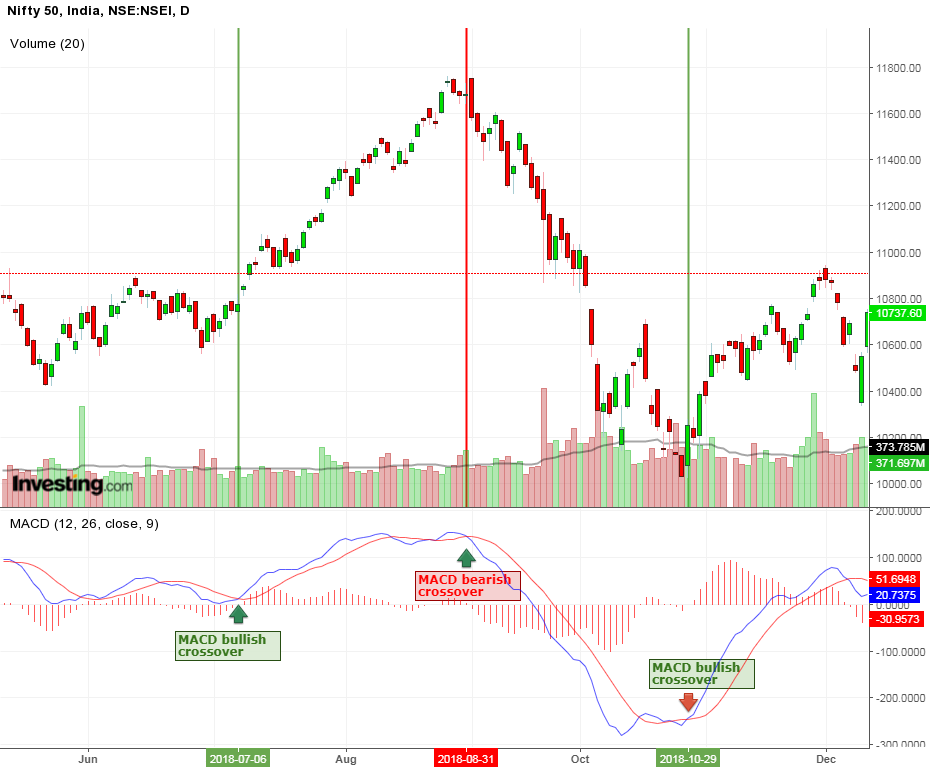
Crossovers are more reliable when they conform to the current trend. If the MACD crosses above its signal line after a brief correction then it qualifies as bullish confirmation.
6. The Relative Strength Index (RSI)
Relative Strength Index is a momentum indicator that measures the magnitude of current price changes to determine whether the stock is overvalued or undervalued. This indicator was originally developed by J. Welles Wilder.
Calculation:
RSI can be broken into two basic components:
- RSI Average Gain
- RSI Average Loss
The RSI calculation is based on 14 periods which is the default as suggested by Wilder. The calculation is divided into two steps:
Step 1:
- First Average Gain = Sum of Gains over the past 14 periods / 14.
- First Average Loss = Sum of Losses over the past 14 periods / 14
Step 2:
- Average Gain = [(previous Average Gain) x 13 + current Gain] / 14.
- Average Loss = [(previous Average Loss) x 13 + current Loss] / 14.
Interpretation:
RSI is considered overbought when above 70 and oversold when below 30.
- Go long when the indicator moves from below to above the oversold line.
- Go short when the indicator moves from above to below the overbought line.
Note here that the direction of crossing is important; the indicator needs to first go past the overbought/oversold lines and then cross back through them.
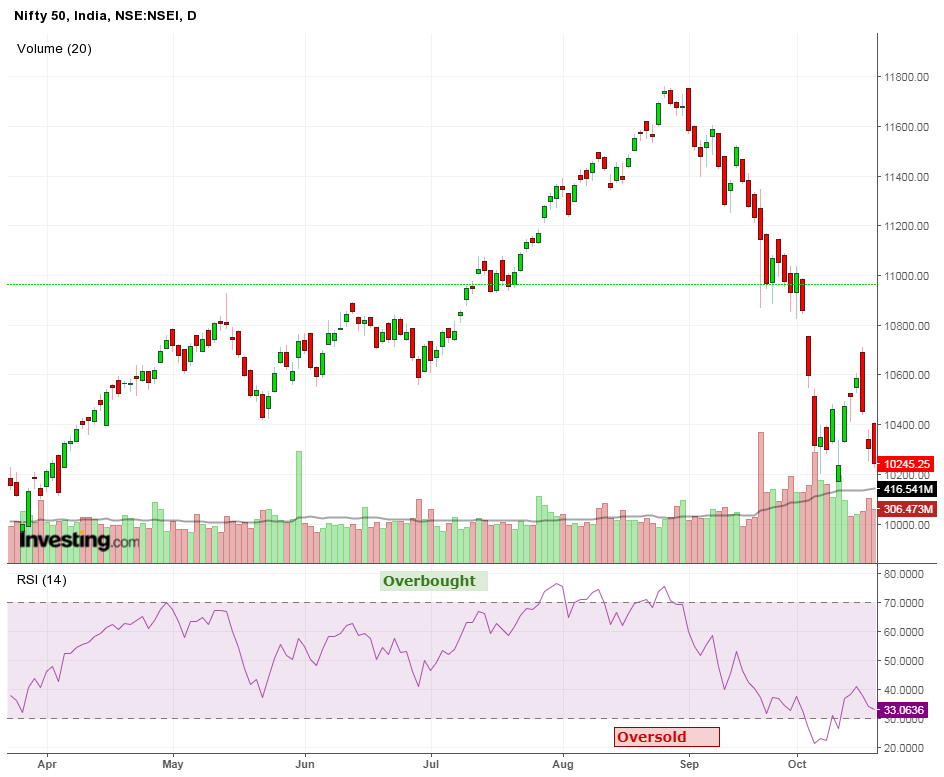
7. The Stochastic Oscillator
The Stochastic Oscillator is an indicator that measures the current price relative to the price range over a number of periods. This indicator was developed by George Lane. It is used to compare where security’s prices close over a selected period. Stochastic most commonly uses 14 periods.
Calculation:
The stochastic indicator is designated by “%K”. This is just a mathematical representation of a ratio.
%K= (today’s Close)-(Lowest low over a selected period)/(Highest over a selected period)- (Lowest low over a selected period)
Interpretation:
This indicator always moves between zero and hundred. Generally reading above 80 is considered to be an overbought zone and reading below 20 is considered to be an oversold zone.
- One should book profit in buy side positions and should avoid new buy side positions in an overbought zone.
- One should book profit in sell side positions and should avoid new sell side positions in an oversold zone.
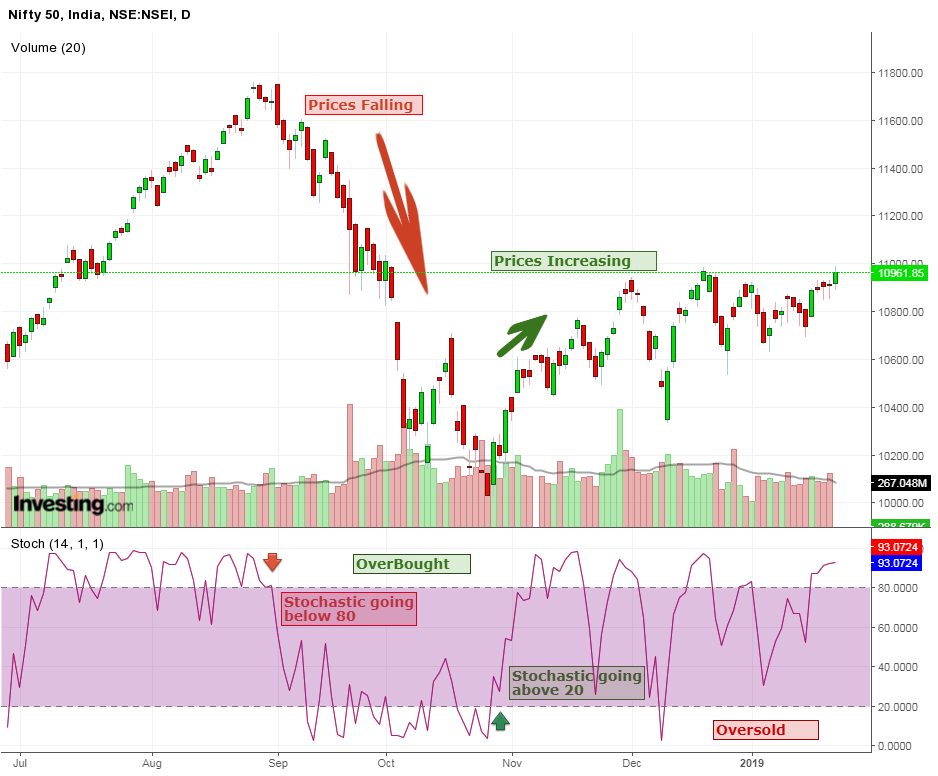
8. Fibonacci Retracement
A Fibonacci Retracement refers to areas of support and resistance. This indicator uses horizontal lines to indicate the areas of support and resistance at the key Fibonacci levels before the trend continues in the original direction
These levels are recognized by drawing a trendline between the high and low and dividing the vertical distance by key Fibonacci ratios of 23.6%, 38.2%,50%, 61.8%, and 100%
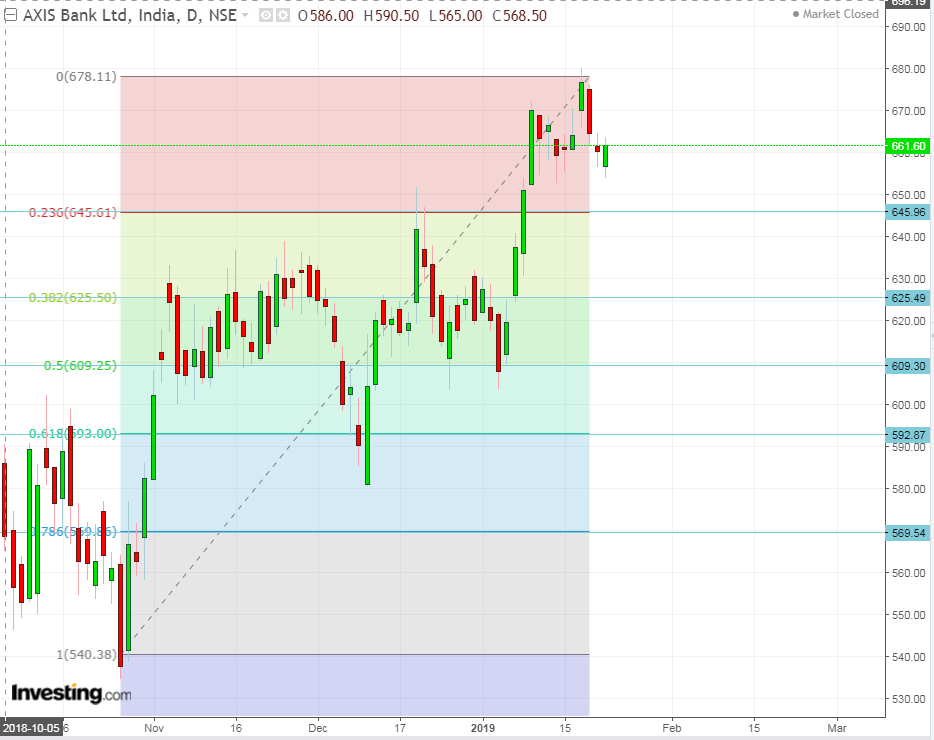
From the above Daily chart of Axis bank, we can see that there is a support level at 645 which is indicated by the Fibonacci Ratio of 23.6%.
9. Parabolic SAR
The Parabolic SAR is one of the best technical analysis indicators which is used to determine the price direction of security and also when the price direction is changing. It is also known as the “stop and reverse system”. It was developed by Welles Wilder.
The Parabolic SAR is graphically shown on the chart of security as a series of dots placed either above or below the price. A small dot is placed above the price in case of a downtrend. On the other hand, the dot is placed below the price in case of an uptrend.
As we can see from the chart below, transaction signals are generated when the position of the dots is reversed and is placed in the opposite direction.
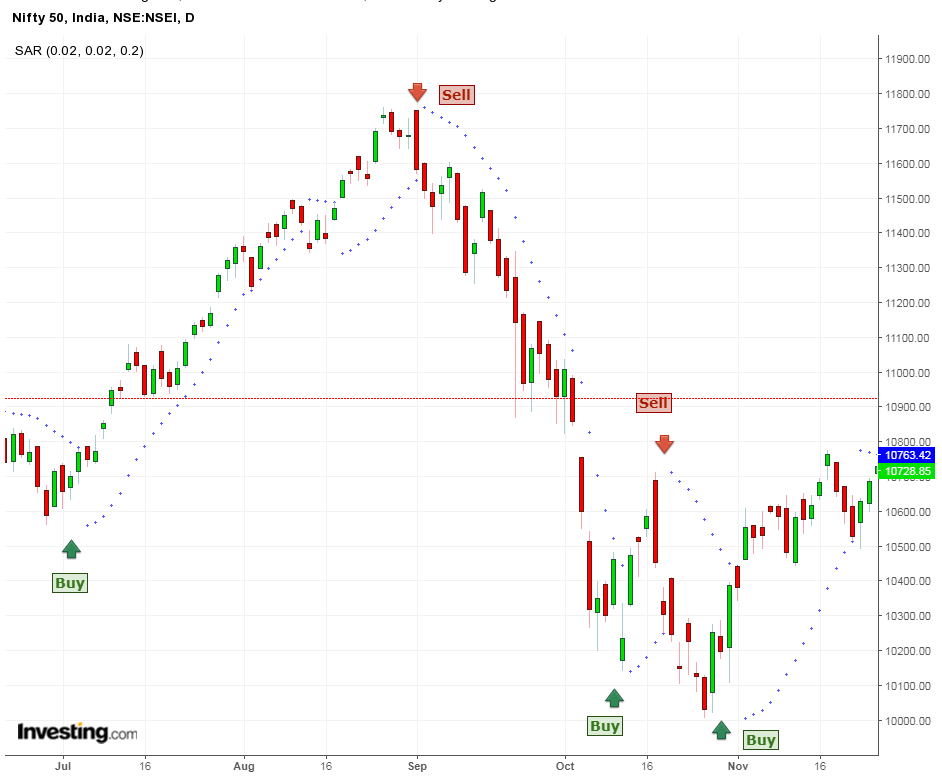
You can also use Technical Scans for filtering out stocks for trading
Frequently Asked Questions
What is a Technical Analysis tool?
The technical Analysis tool is used for analyzing technical charts and for predicting whether the ongoing trend will continue or reverse.
What 5 technical analysis indicators are vital to your trading?
Technical analysis indicators like MACD, RSI, Stochastics, OBV, and Fibonacci are vital for trading.
What are the best technical analysis indicators for hourly and daily charts?
Traders can use indicators like MACD, RSI, and Stochastics for hourly and daily charts.
How did you learn to use technical analysis indicators for options trading?
The best way to learn technical analysis indicators is by understanding how they work and then applying that knowledge via backtesting or paper trading.
Many brokers and websites offer electronic platforms that offer simulated trading that resemble live markets like StockEdge, Investing.com where you can apply these tools.
Bottomline
As discussed above, these technical analysis indicators help us in earning profits. It will be much better if we use the combination of 2-3 technical indicators while selecting stocks.
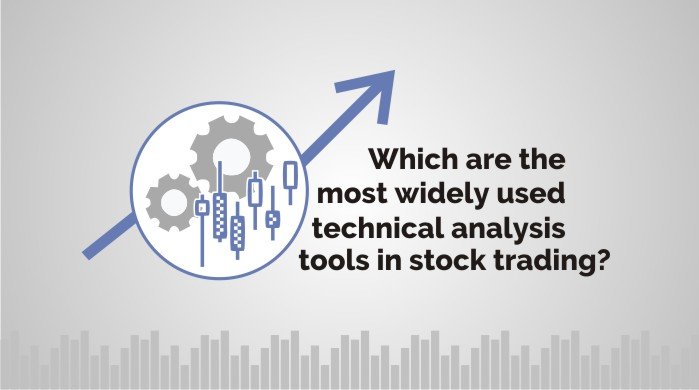




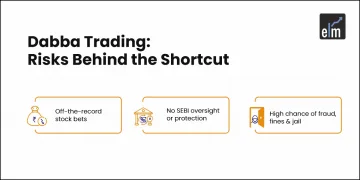

Where can I get these indicators from.
Hello DN,
Thank you for your comment.
You can get these indicators from Investing.com free of cost
To get a comprehensive idea on technical analysis you may enroll in:Certification in Online Technical Analysis
Happy Learning!!
Just bringing your attention to the rectification required in above explanation– when the dots are below the
price it would be uptrend and when dots go above the price , the down trend would begin . it shows the mistake is done inadvertantly.
Hi,
Thank you for your feedback.We have corrected the mistake.
Thanks for Reading!
Keep Reading!
I appreciate, result in I found exactly what I was looking for. You’ve ended my four day long hunt! God Bless you man. Have a nice day. Bye
Very good and informative to the stock market learners. Thanks for providing such a valuable information.
i had lost my whole life capital and very important five years also lot of happyness in share market . can you help me to return all these once again .
any tool or indicator as highest reliable or trustable .
thank you for your suggestions means a lot
Hi,
We really appreciated that you liked our blog.
Keep Reading!
Hi
The article was very good and practical.
This article will help you predict the price
Thanks
Hi,
We really appreciated that you liked our blog! Thank you for your feedback!
Keep Reading
this was really helpful Information I learnt a lot
Hi,
We really appreciated that you liked our blog! Thank you for your feedback!
Keep Reading!